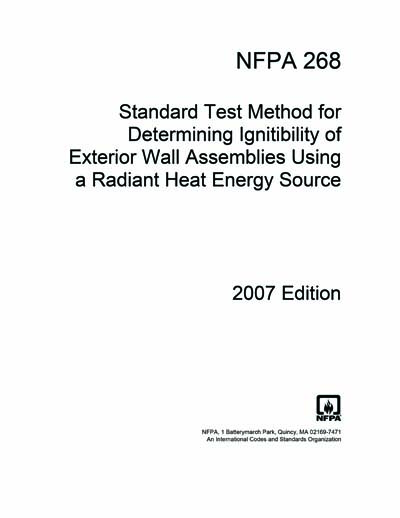Historical
NFPA 268-2007
NFPA 268: Standard Test Method for Determining Ignitability of Exterior Wall Assemblies Using a Radiant Heat Energy Source, 2007 Edition
1.1 Scope. 1.1.1 This fire test response standard describes a method for determining the propensity of ignition of exterior wall assemblies from exposure to 12.5 kW/m2 (1.10 Btu/ft2-sec) radiant heat in the presence of a pilot ignition source. 1.1.2 This test method evaluates the propensity of ignition of an exterior wall assembly where subjected to a minimum radiant heat flux of 12.5 kW/m2 (1.10 Btu/ft2-sec). This method determines whether ignition of an exterior wall assembly occurs when the wall is exposed to a specified radiant heat flux, in the presence of a pilot ignition source, during a 20-minute period. 1.1.3 This test method utilizes a gas-fired radiant panel to apply a radiant heat flux of 12.5 kW/m2 (1.10 Btu/ft2-sec) to a representative sample of an exterior wall assembly while the test specimen is exposed simultaneously to a pilot ignition source. 1.1.4 This test method applies to exterior wall assemblies having planar, or nearly planar, external surfaces. 1.1.4.1 This method shall not be used to evaluate the fire endurance of wall assemblies, nor shall it be used to evaluate the effect of fires originating within the building or within the exterior wall assemblies. 1.1.4.2 This method shall not be used to evaluate surface flame spread, nor shall it be used to evaluate the influence of openings for their propensity of ignition.
National Fire Protection Association [nfpa]

